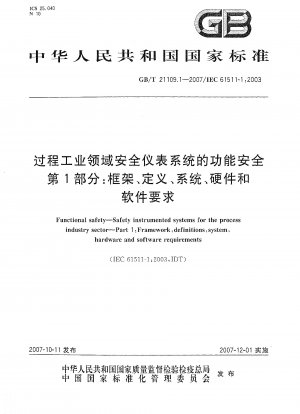GB/T 21109.1-2007
Functional safety.Safety instrumented systems for the process industry sector.Part 1:Framework,definitions,system,hardware and software requirements (English Version)
- Standard No.
- GB/T 21109.1-2007
- Language
- Chinese, Available in English version
- Release Date
- 2007
- Published By
- General Administration of Quality Supervision, Inspection and Quarantine of the People‘s Republic of China
- Status
- 2023-05
- Replace By
- GB/T 21109.1-2022
- Latest
- GB/T 21109.1-2022
- Scope
- This part of GB/T 21109 gives the specification, design, installation, operation and maintenance requirements of the safety instrumented system, which ensures that the system can put or maintain the process in a certain safe state. GB/T 21109 has been formulated as the implementation of GB/T 20438-2006 in the process field. In particular, this part: a) specifies the requirements for achieving functional safety but does not specify who is responsible for achieving these requirements (e.g. designers, suppliers, ownership/operating companies, contractors); depending on safety planning and national regulations , responsibilities may be assigned to different responsible parties. B) It is suitable for integrating equipment that meets the requirements of GB/T 20438-2006 or ll.5 in this part into an overall system that can be used in process field applications, but it is not suitable for safety instrumented systems that want to declare that the device is suitable for process fields Manufacturers (see GB/T 20438.2-2006 and GB/T 20438.3-2006). C) Define the relationship between GB/T 21109 and GB/T 20438-2006 (Figure 2 and Figure 3). D) Applicable to the development of application software for systems using limited variable languages or fixed programming languages, not applicable to manufacturers, safety instrumented system designers, and integrators who develop embedded software (system software) or use fully variable languages and users (see GB/T 20438.3-2006). E) Applicable to a wide range of industrial fields in process fields including chemical, oil refining, oil and gas production, pulp and paper, non-nuclear power production. Note: In some process area applications (such as offshore), some additional requirements may also need to be met. F) The relationship between the instrumented safety function and other functions is drawn (Figure 4). G) Identify the functional and safety integrity requirements for the instrumentation safety function, taking into account the risk reduction achieved by other means. H) Specifies the system structure, hardware configuration, application software and system integration requirements. i) Specifies the application software requirements for users and integrators of safety instrumented systems (Chapter 12), specifically specifying the requirements for: — the various safety lifecycle phases and activities to be used during the design and development of application software (Software Security Lifecycle Model). These requirements include the application of measures and techniques aimed at avoiding faults in software and controlling failures that may occur. - Information related to software safety validation to be communicated to the organization performing the SIS integration. — Preparation of information and procedures related to user-required software for SIS operation and maintenance. — the procedures and specifications to be met by organizations performing modifications to secure software. J) May be used when one or more instrumented safety functions are used to achieve functional safety for the protection of persons, protection of the public or protection of the environment. K) Also suitable for non-safety applications (eg asset protection). 1) Requirements for implementing instrumented safety functions are identified, which are used as part of an overall arrangement for implementing functional safety. M) The safety lifecycle (Figure 8) is used and the list of activities necessary to determine the safety instrumented system functional requirements and safety integrity requirements is defined. N) A hazard and risk assessment is required to determine the safety functional requirements and safety integrity level for each instrumented safety function. Note: See Figure 9 for an overview of risk reduction approaches. O) Numerical targets for the mean probability of failure on demand and the frequency of dangerous failures per hour are established for the safety integrity level. P) specifies the minimum requirements for hardware failure margin. Q) specifies the techniques/measures required to achieve the required integrity level. R) Determine the highest performance level (SIL4) that can be achieved by the instrumentation safety function realized according to GB/T 21109. S) Determine the minimum performance level (SIL 1) below which GB/T 21109 does not apply. T) provides a framework for determining the safety integrity level, but does not specify the safety integrity level required for a specific application (it should be determined based on knowledge of the specific application). U) specifies the requirements for each part of the safety instrumented system (from the sensor to the final element). V) defines the information required within the safety life cycle. W) It is required that the design of instrument safety functions should take human factors into consideration. X) Make no direct demands on individual operators or maintenance personnel. The relationship between the system, hardware and software in this part is shown in Figure 5.
GB/T 21109.1-2007 Referenced Document
- GB/T 17214.1-1998 Industrial-process measurement and control equipment--Operating conditions. Part 1: Climatic conditions
- GB/T 18268-2000 Electrical equipment for measurement,control and laboratory use--EMC requirements
- GB/T 20438.2-2006 Functional safety of electrical/ electronic/ programmable electronic safety-related systems. Part 2: Requirements for electrical/ electronic/ programmable electronic safety-related systems
- GB/T 20438.3-2006 Functional safety of electrical/ electronic/ programmable electronic safety-related systems. Part 3: Software requirements
- GB/T 21109.2-2007 Functional safety.Safety instrumented systems for the process industry sector.Part 2:Guidelines for the application of GB/T 21109.1
GB/T 21109.1-2007 history
- 2022 GB/T 21109.1-2022 Functional safety of safety instrumented systems in the process industry sector—Part 1: Framework, definitions, system,hardware and application programming requirements
- 2007 GB/T 21109.1-2007 Functional safety.Safety instrumented systems for the process industry sector.Part 1:Framework,definitions,system,hardware and software requirements

GB/T 21109.1-2007 -All Parts
GB/T 21109.1-2022 Functional safety of safety instrumented systems in the process industry sector—Part 1: Framework, definitions, system,hardware and application programming requirements
GB/T 21109.2-2023 Functional safety of safety instrumented systems for the process industry sector—Part 2:Guidelines for the application of GB/T 21109.1—2022
GB/T 21109.3-2007 Functional safety.Safety instrumented systems for the process industry sector.Part 3:Guidance for the determination of the required safety integrity levels